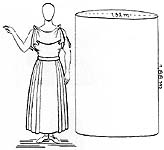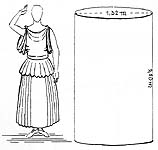 |
||||
|
Lesson #3: Page 2
The height of these dresses would mean that the top of the dress could be folded over into a cape and/or the dress could be heavily bloused over a girdle, both features seen in continental pictorial representations. Judging from the remains from Anglo-Saxon graves it seems likely that the top was not folded, but any excess would have been taken up by blousing. There are numerous ways of wearing a peplos dress, involving anything from one to three brooches, although two is definitely the most common number. It seems the early Germanic settlers were fond of a symmetrical look and most of the pairs of brooches are identical, or at least very similar. The girdle is usually worn around the waist or hips, although at least one source shows the women wearing the gown pulled in just below the breasts, then hanging loose, an arrangement which may have been comfortable during early pregnancy. The folds of the gown usually conceal the belt, but a few sources show a second visible belt. This garment was usually worn ankle length, although, if worn over an underdress, it may sometimes have been worn calf length. These garments were often edged with tablet weave, at least at the top edge, and probably sometimes also at the bottom. The style of brooches worn #2 seem to form a regional pattern: quoit brooches were worn only south of the Thames and, like the equal armed brooch (which was common in Anglian areas), were known only in the fifth century. Radiate headed brooches, bird-shaped brooches and inlaid brooches were largely characteristic of Kent in the sixth century, although a few radiate headed brooches occur in other areas too. Small Cruciform brooches were sometimes worn in pairs in Anglian areas from the fifth to seventh centuries. Annular brooches were especially favoured by the Northumbrian and East Angles from the late fifth to the seventh centuries. Saucer brooches were most popular in Saxon areas from the late fifth to the seventh century, and seem to be a development of the applied brooch which first appeared in North Germany in the fourth century and continued in use (in Germany and England) until the sixth century. Disc brooches were a uniquely southern English development with no continental counterpart which began in the fifth century and continued throughout the sixth century. A specialized type of disc brrooch, the openwork brooch was popular in the south midlands at the same time. Long brooches, in all their forms seem to have been fairly universal in a wide variety of forms from the early fifth until the late sixth or early seventh century. Some poorer female graves have lacked the pairs of shoulder brooches, and it is possible that in these cases the two edges were sewn together, rather than pinned with brooches. Peplos gowns were usually made of wool, most often a twill although a few were may have been made of linen. We do not know what name was given to this garment, although slop and wealca are the most likely. The peplos gown could be worn on its own, although it was often worn over a sleeved underdress. Click on image for larger version in new window Making a 'Peplos' Gown
Click on image for larger version in new window
1 Although the term Peplos is generally used to describe this type of gown, it properly refers to the item worn in ancient Greece, and the term was not used by the Anglo-Saxons. back 2 We will be looking in more detail at the different styles of brooches and other jewellery in a later lesson. back 3 Although
this sounds quite risqué, when pinned at the shoulder and belted
at the waist it is not too revealing! back
Page
1 | Page 2 | Page 3 | Page
4 | Page 5 | Page
6 | Page 7 | Page
8
|
||||
| Costume
Classroom is a division of The
Costume Gallery, copyright 1997-2002.
Having problems with this webpage contact: questions@costumeclassgallery.com |












